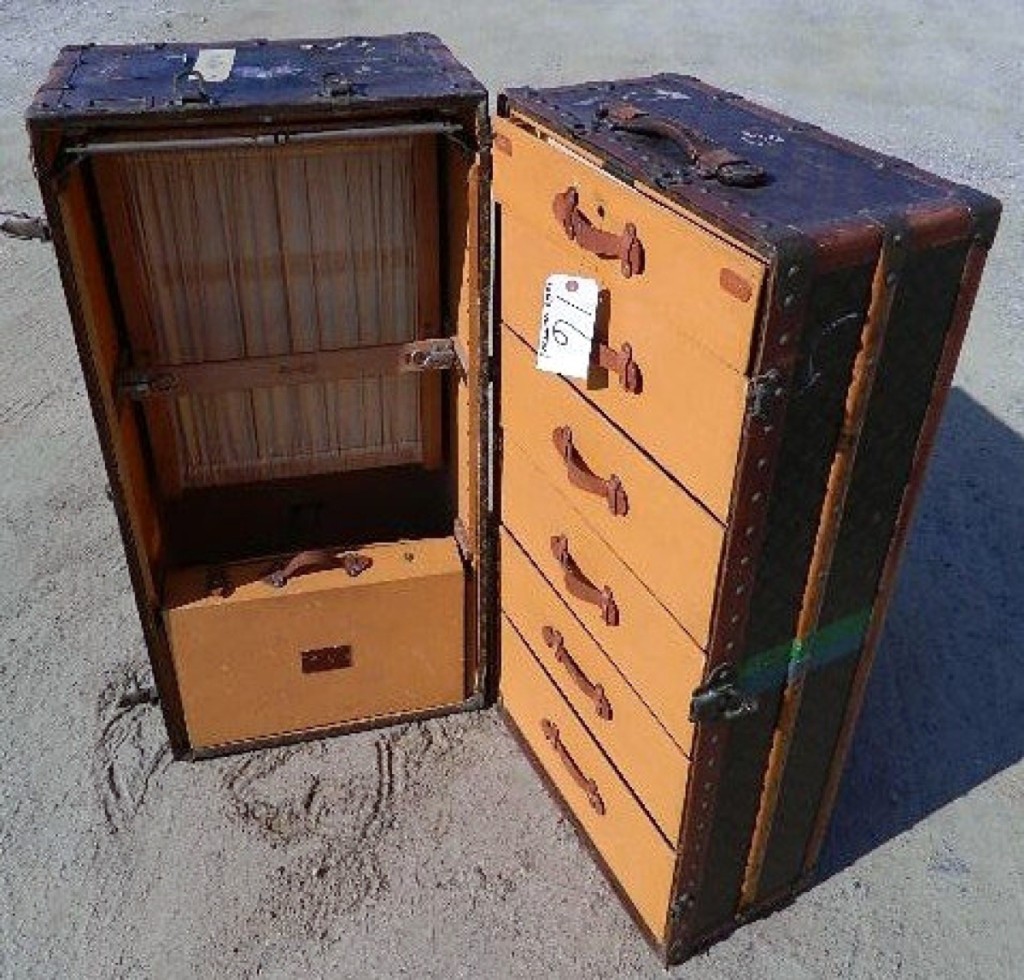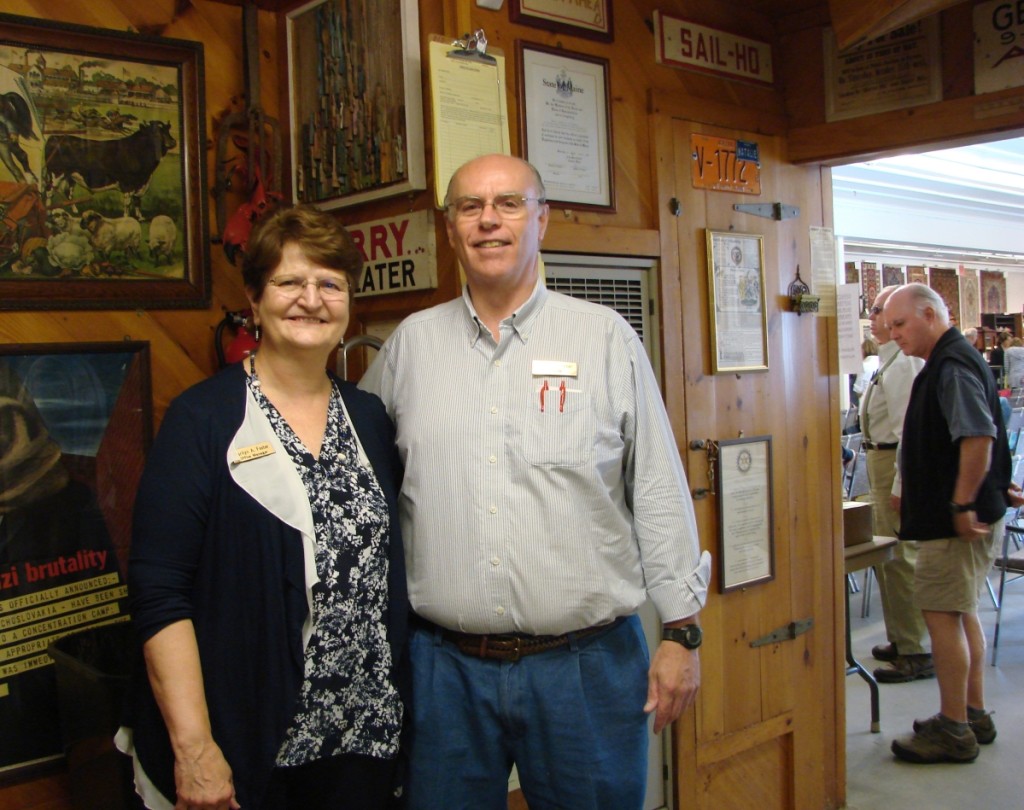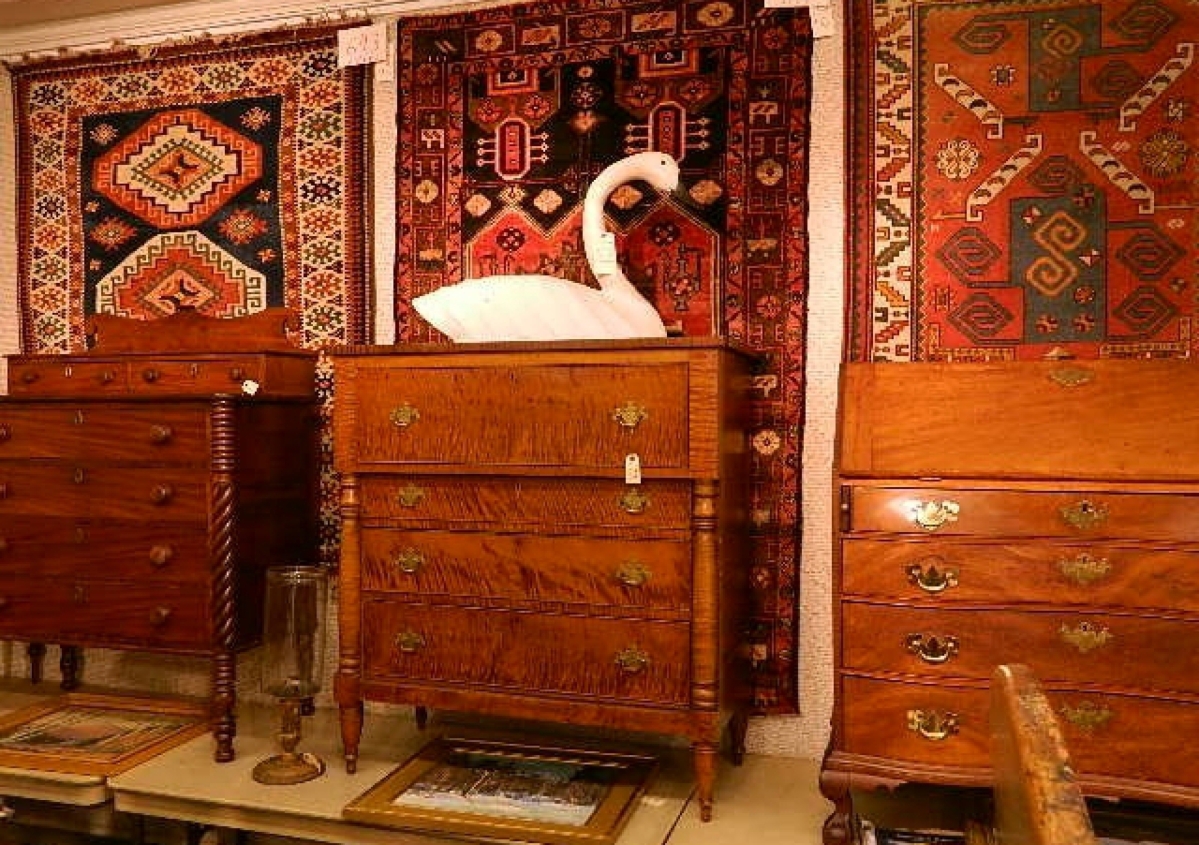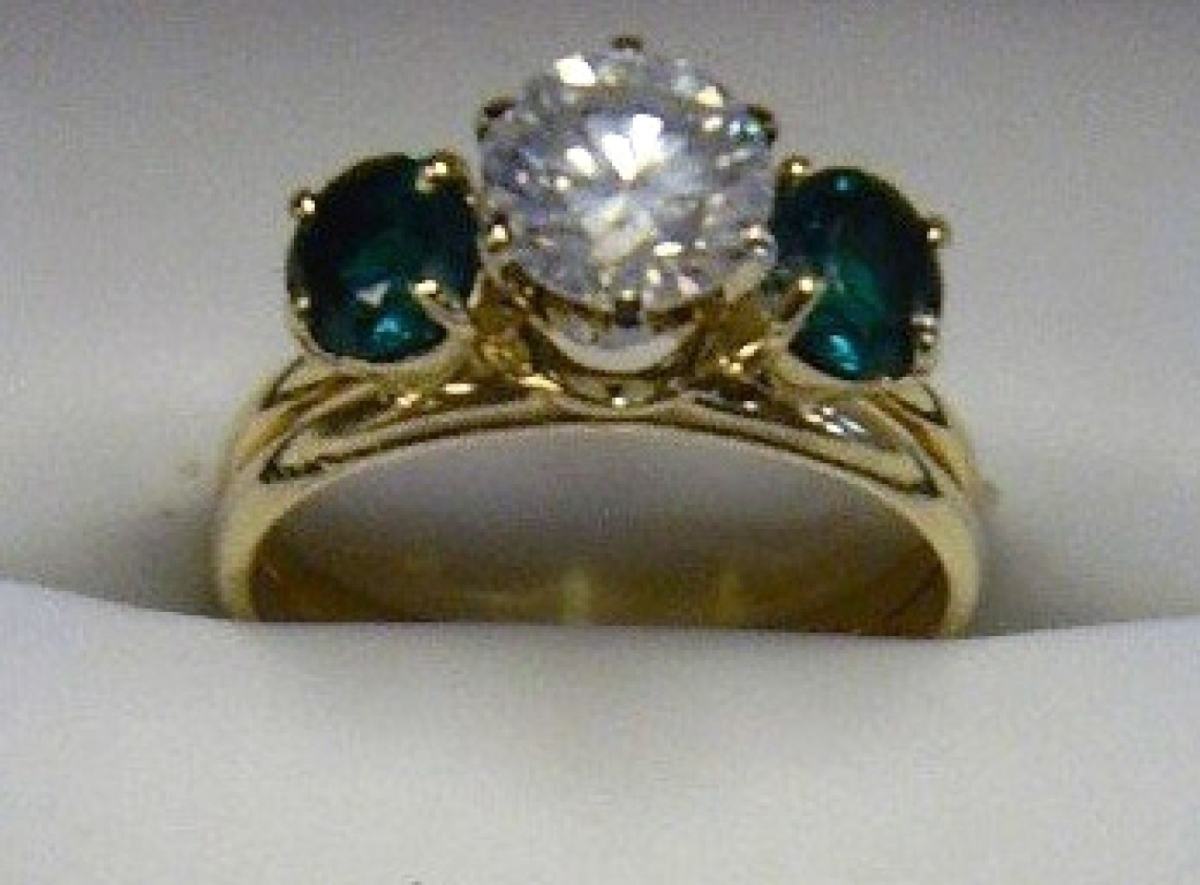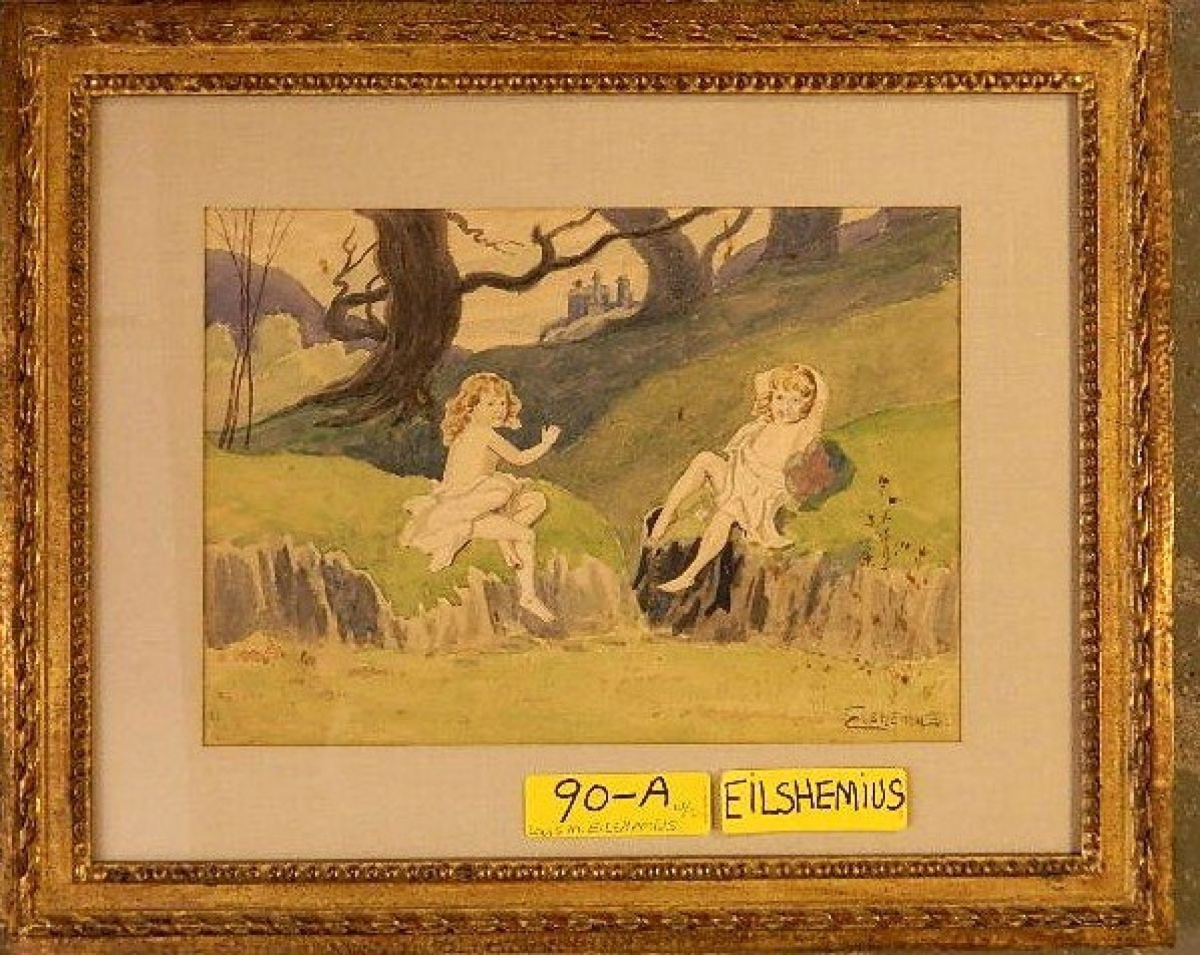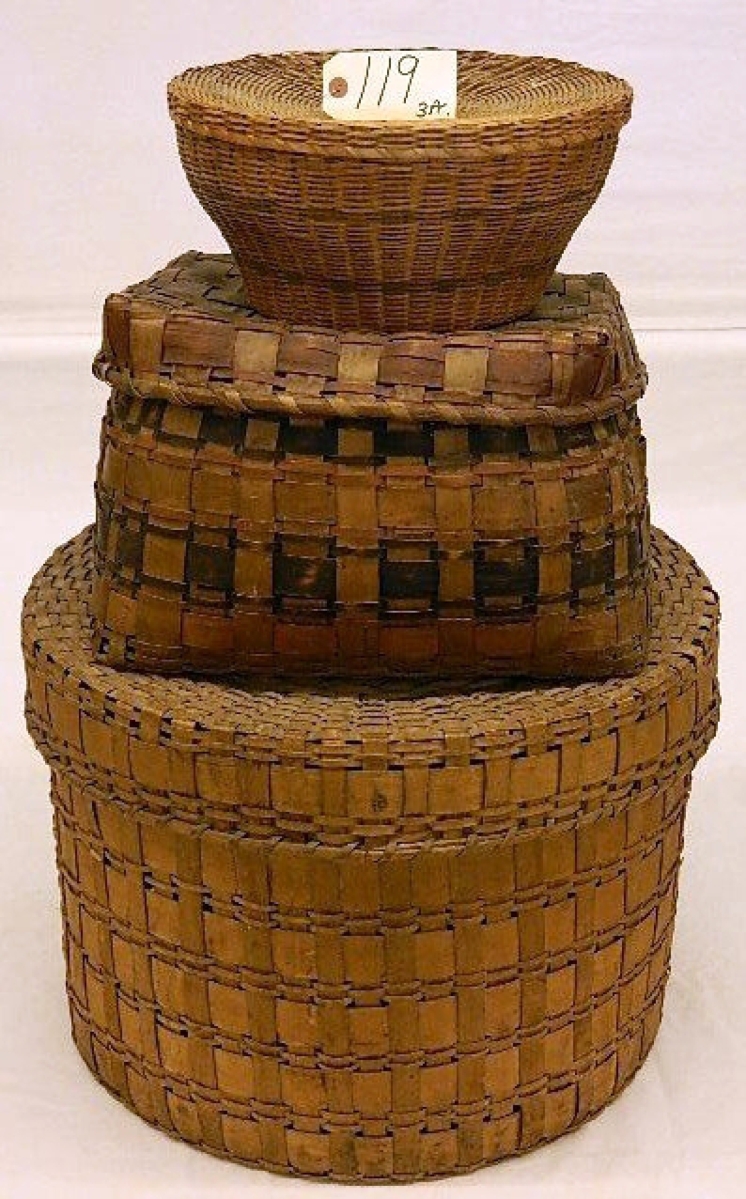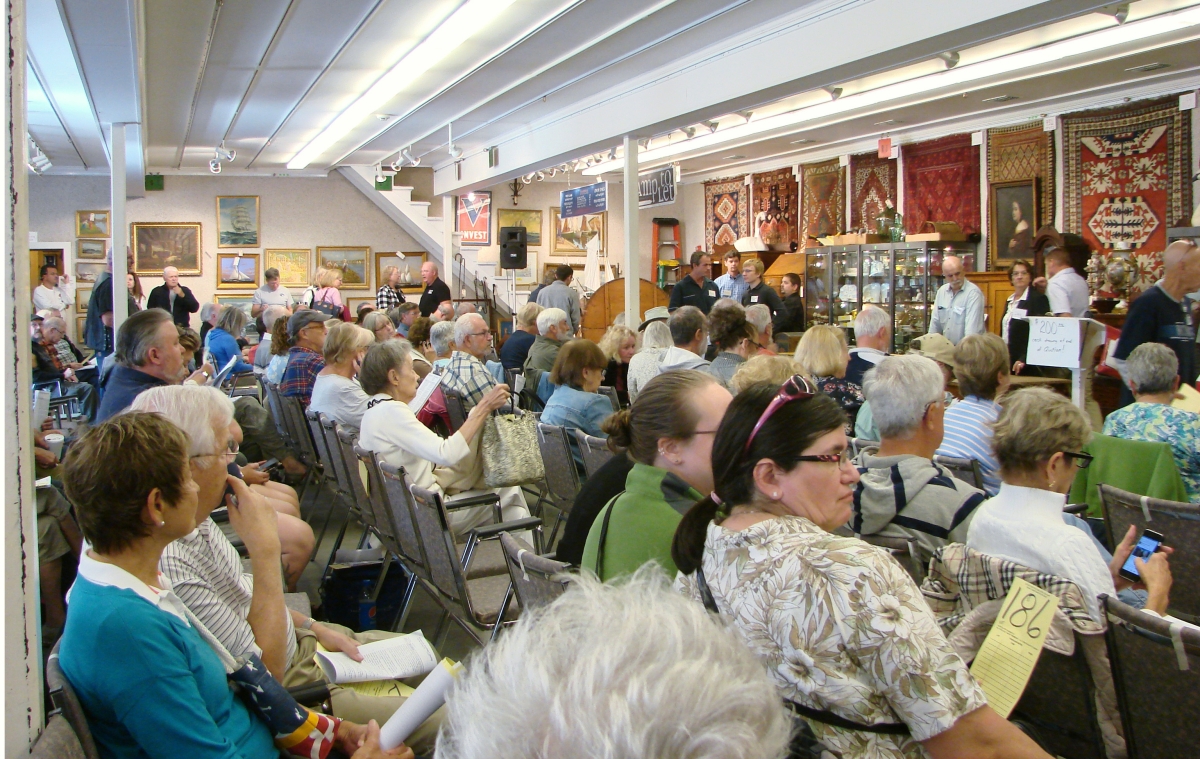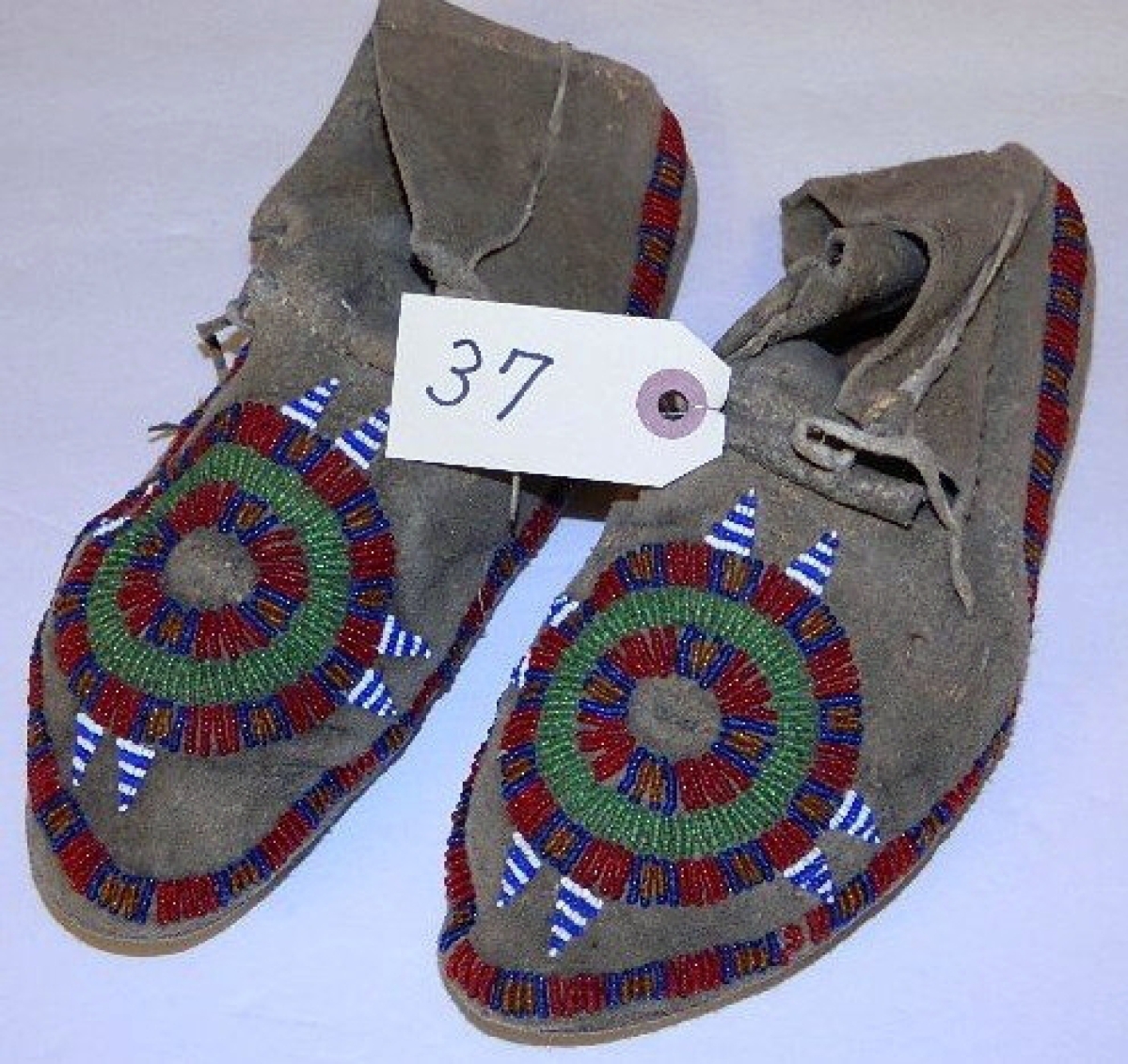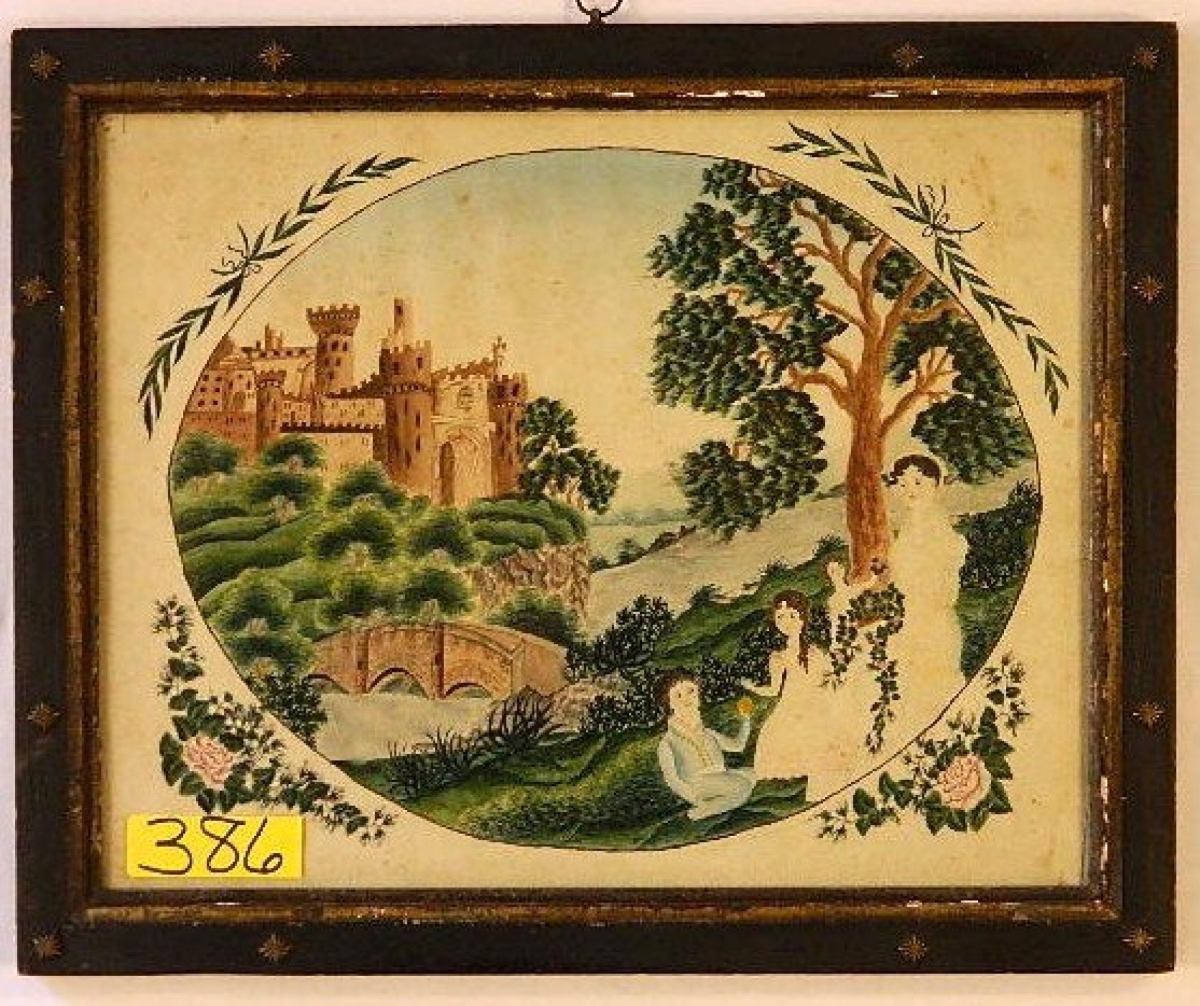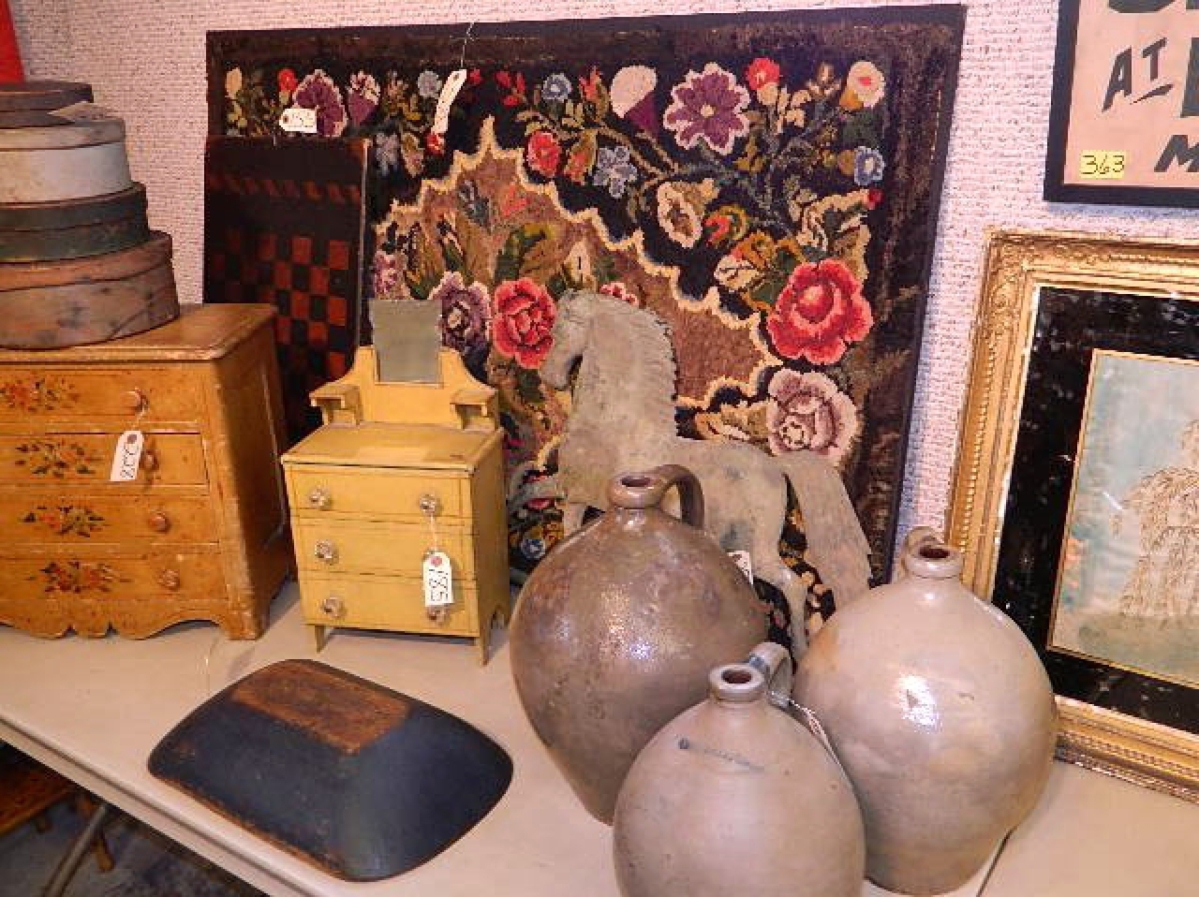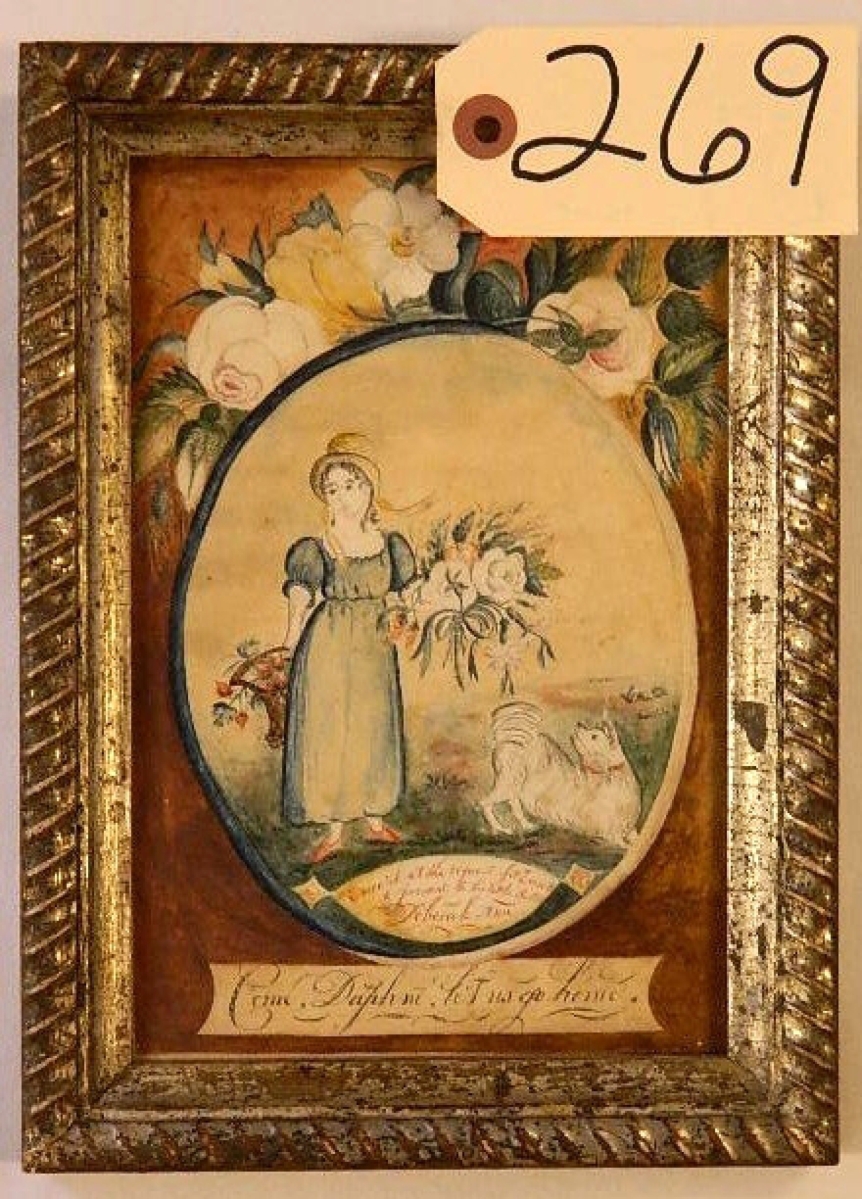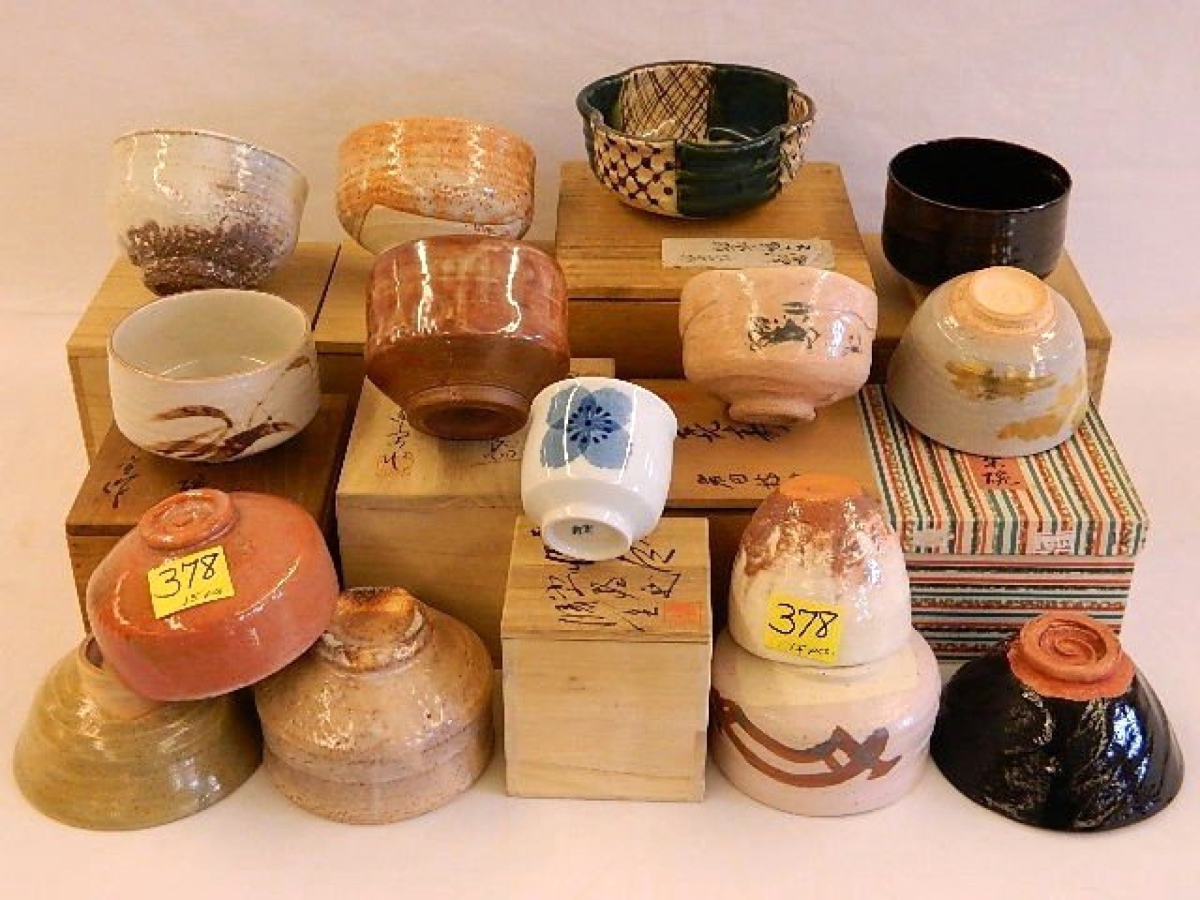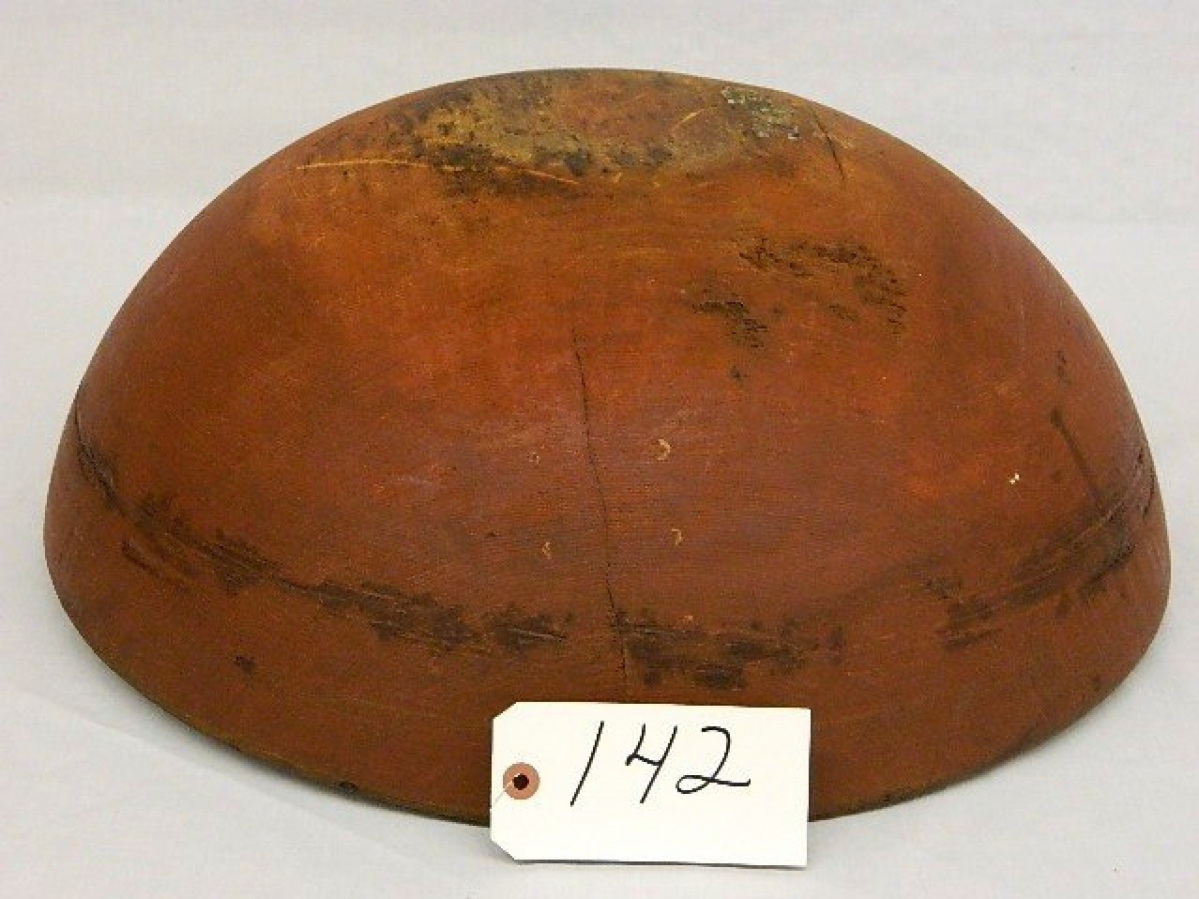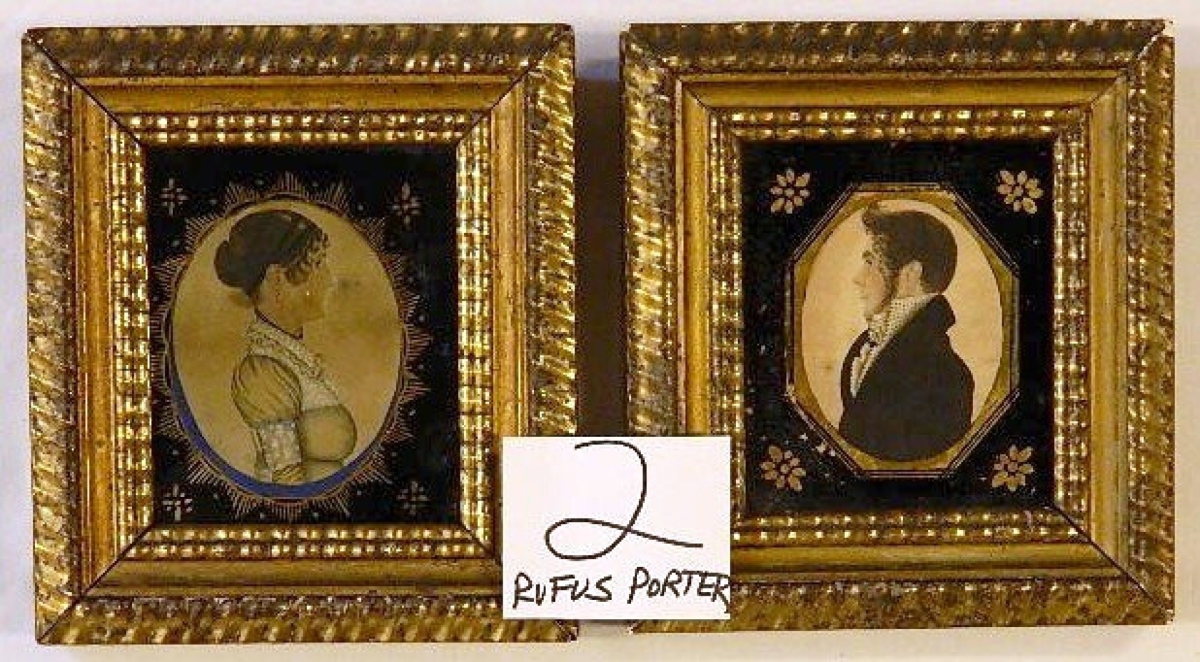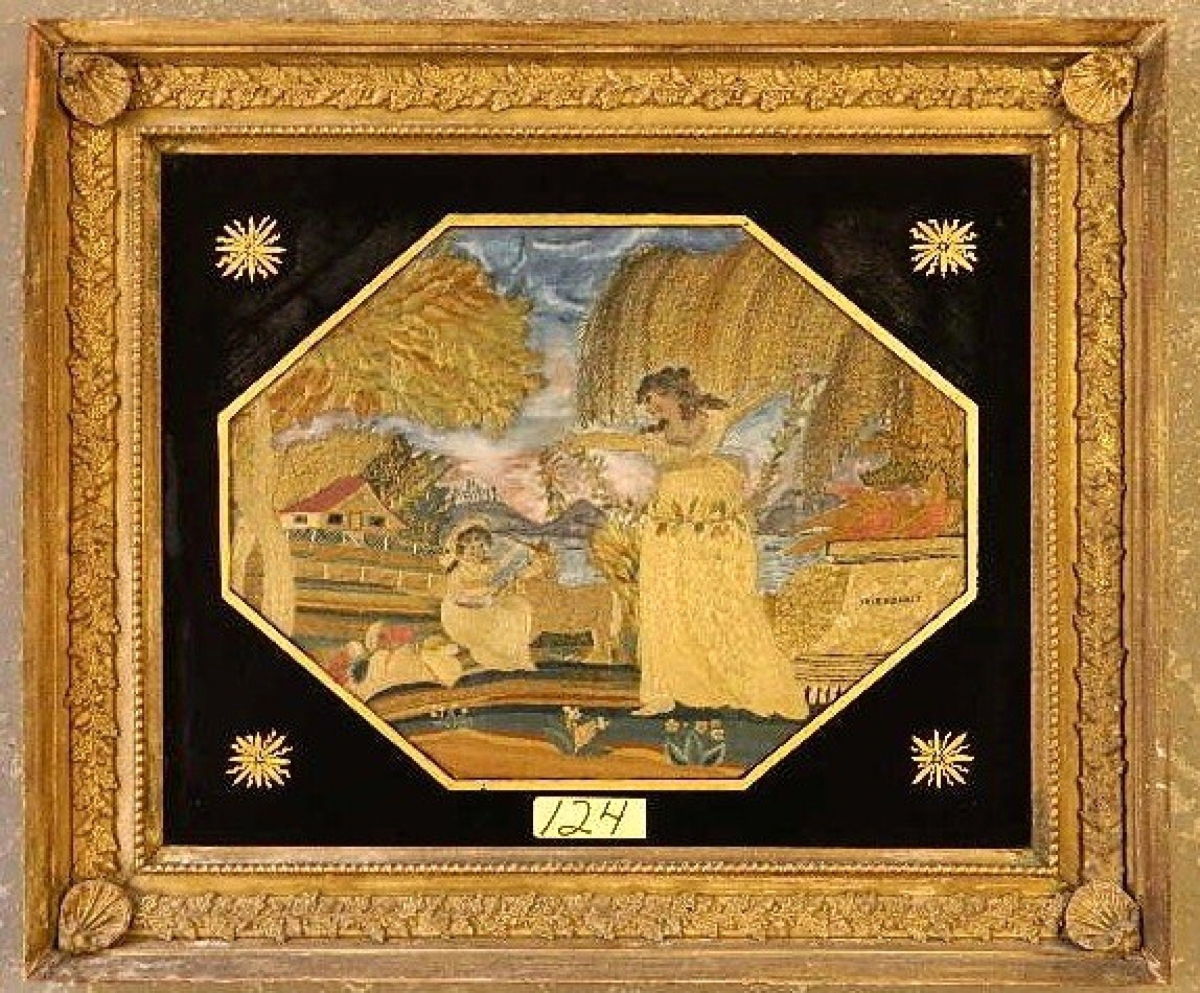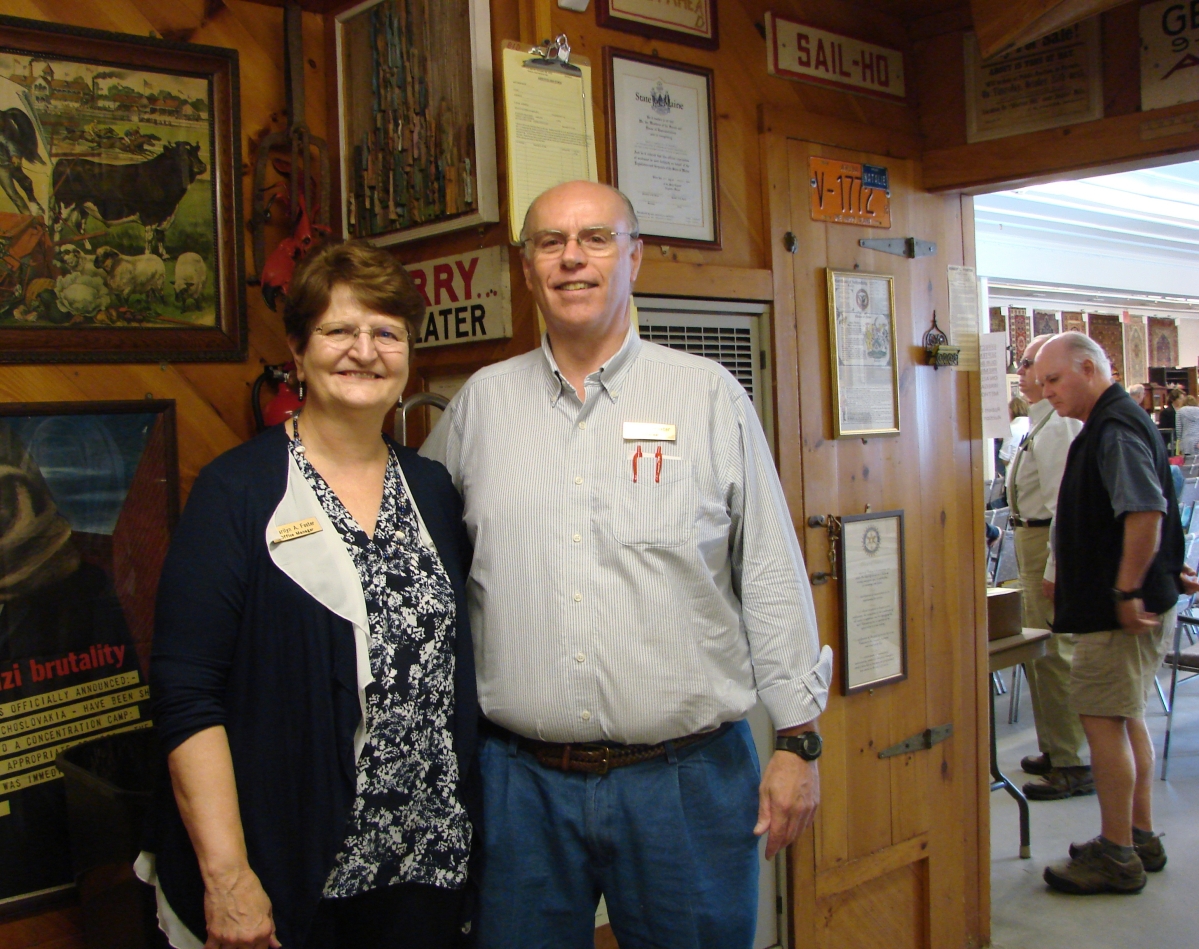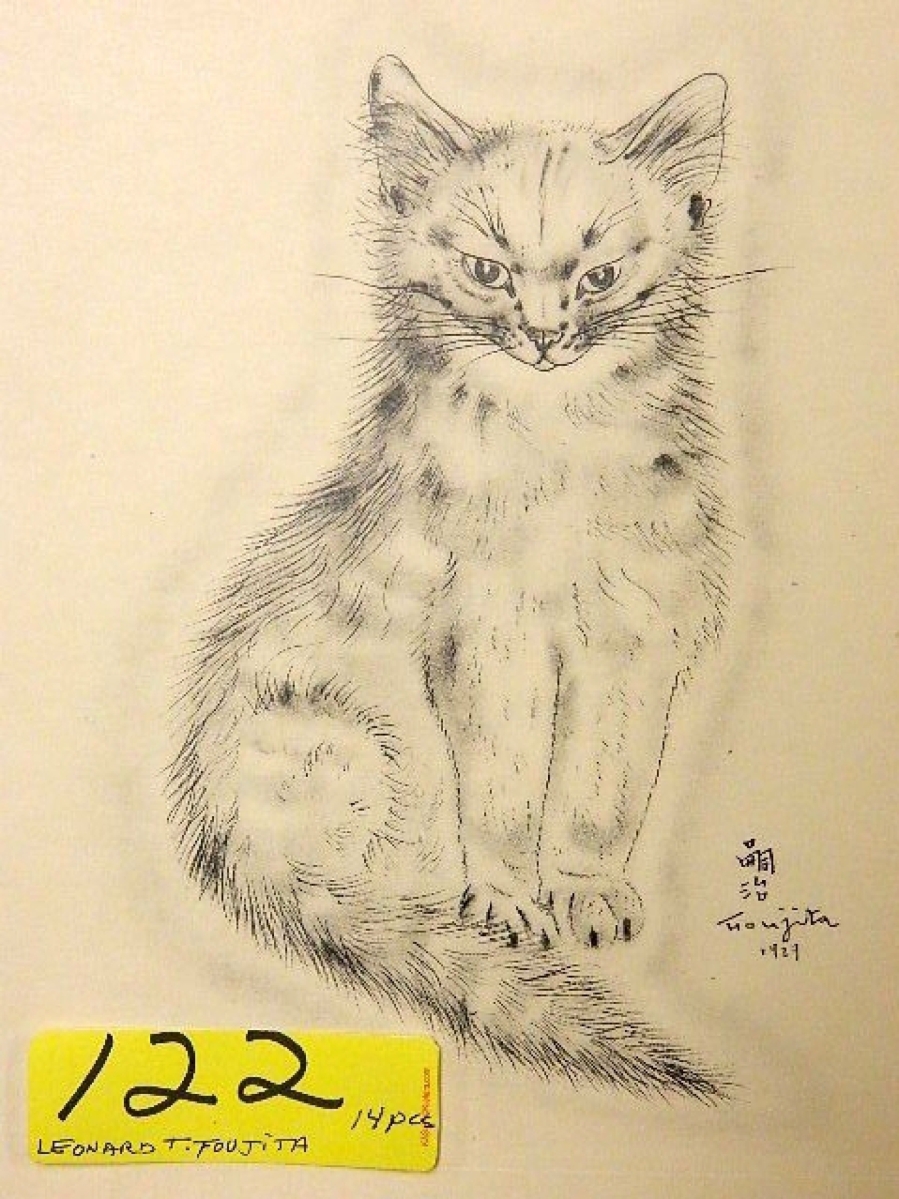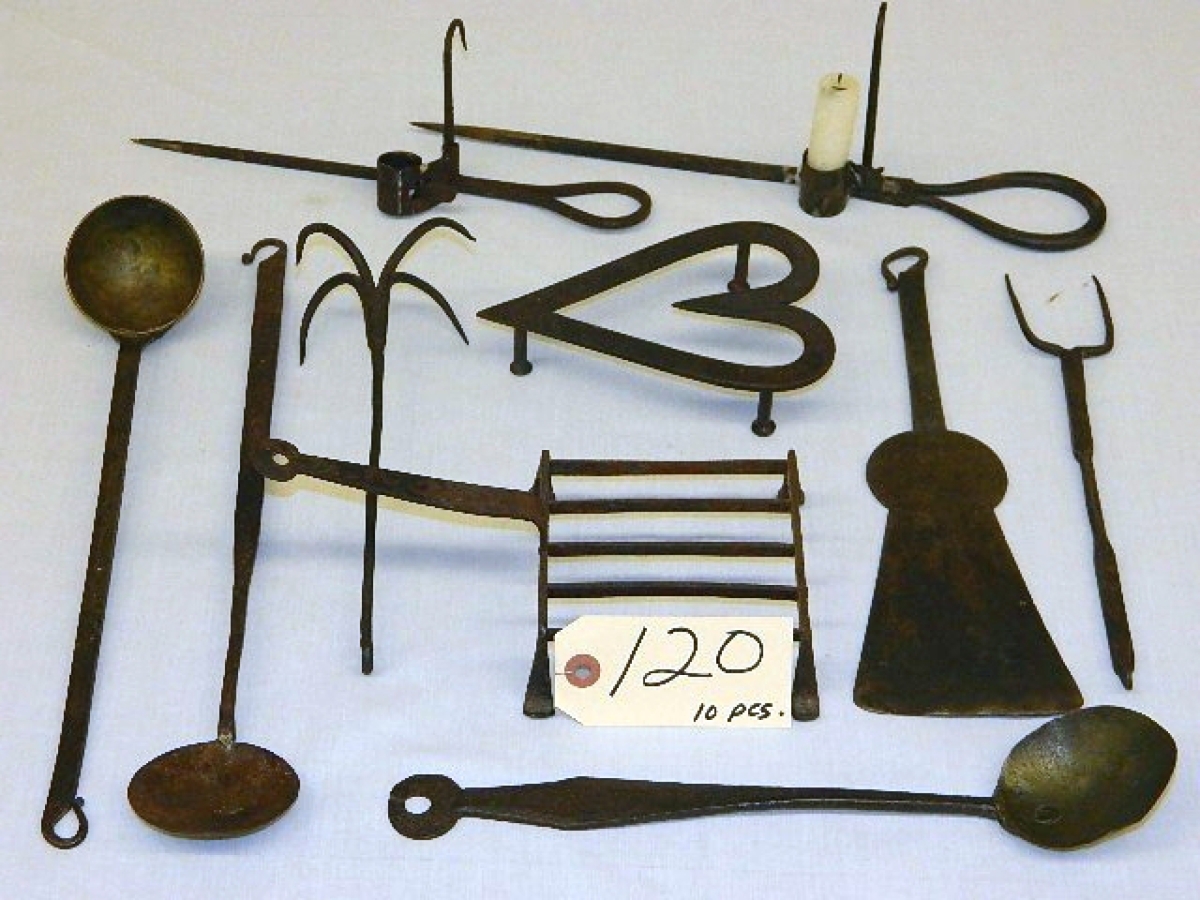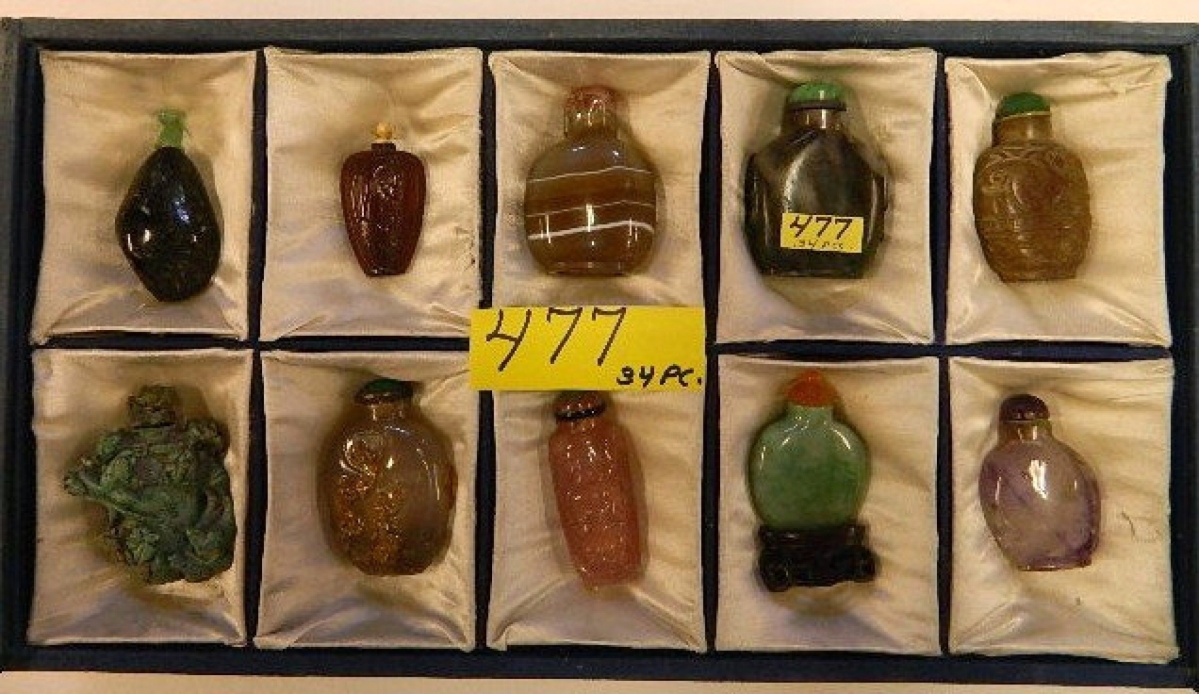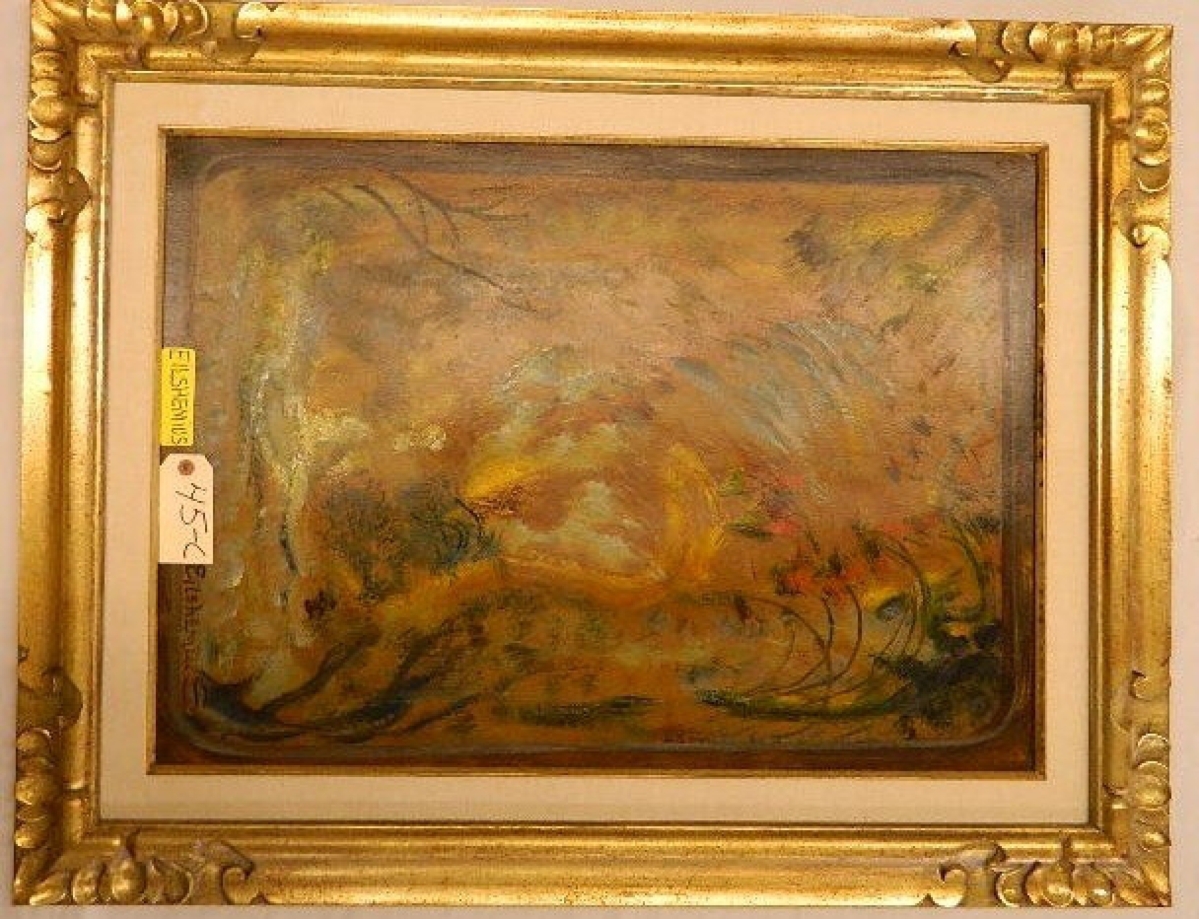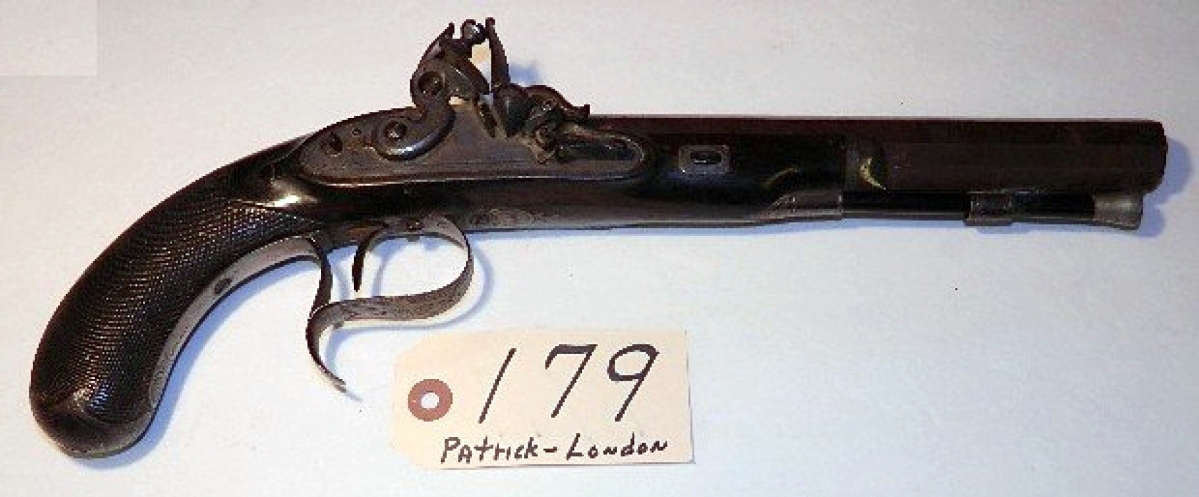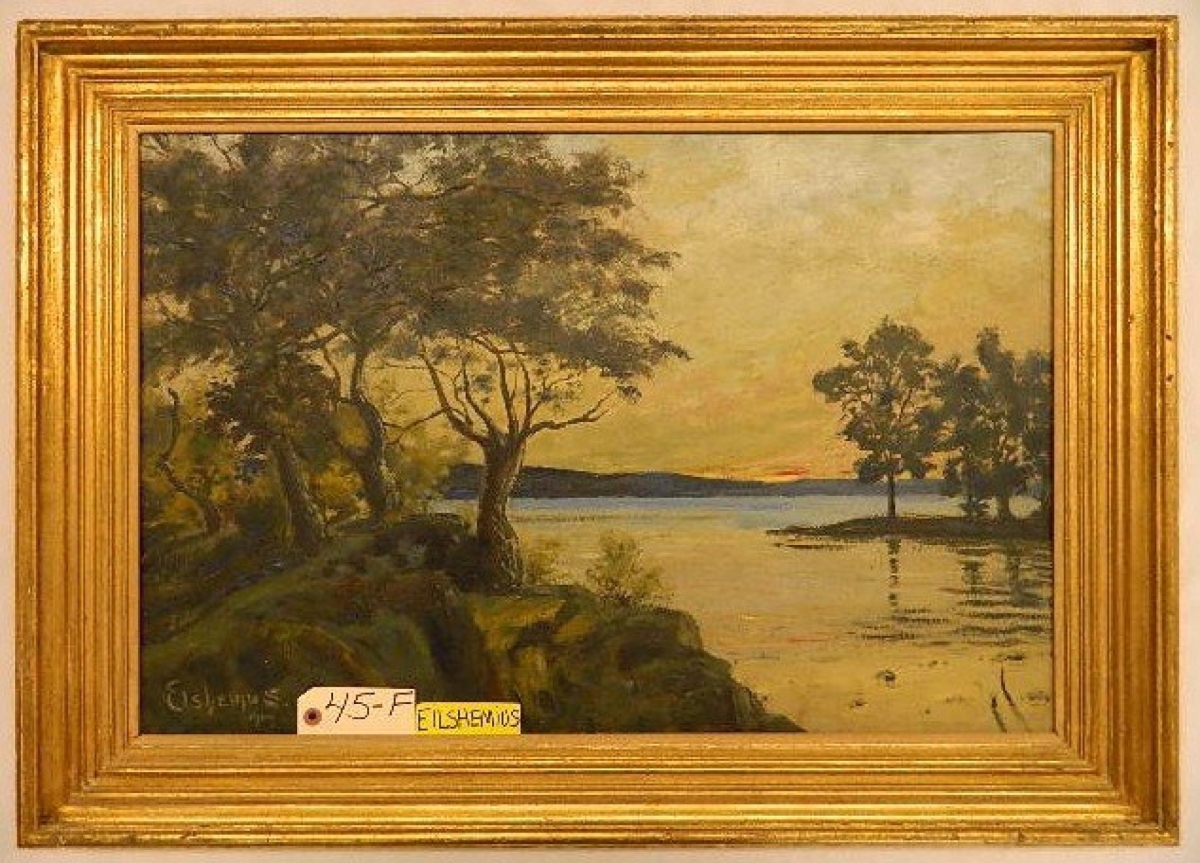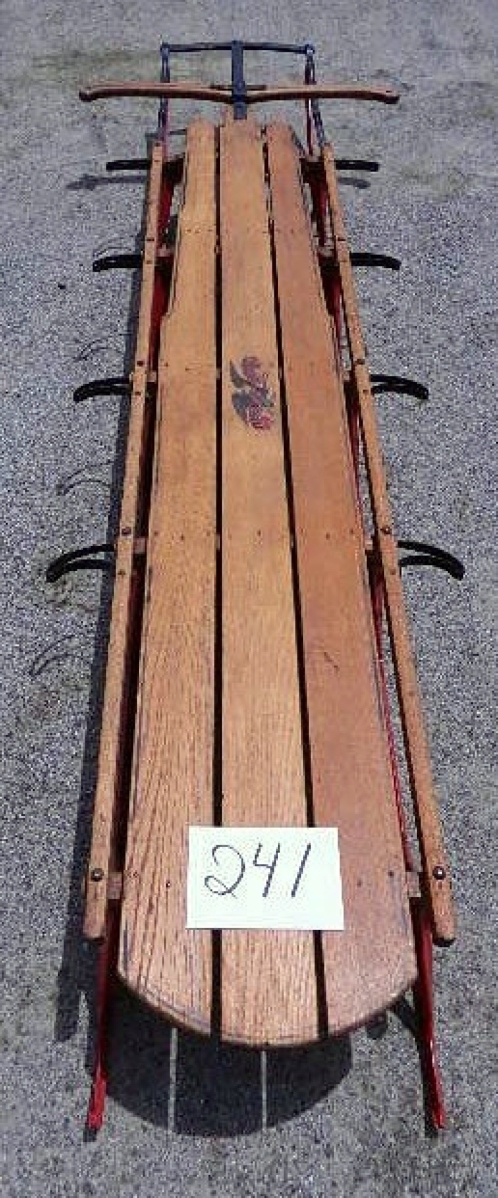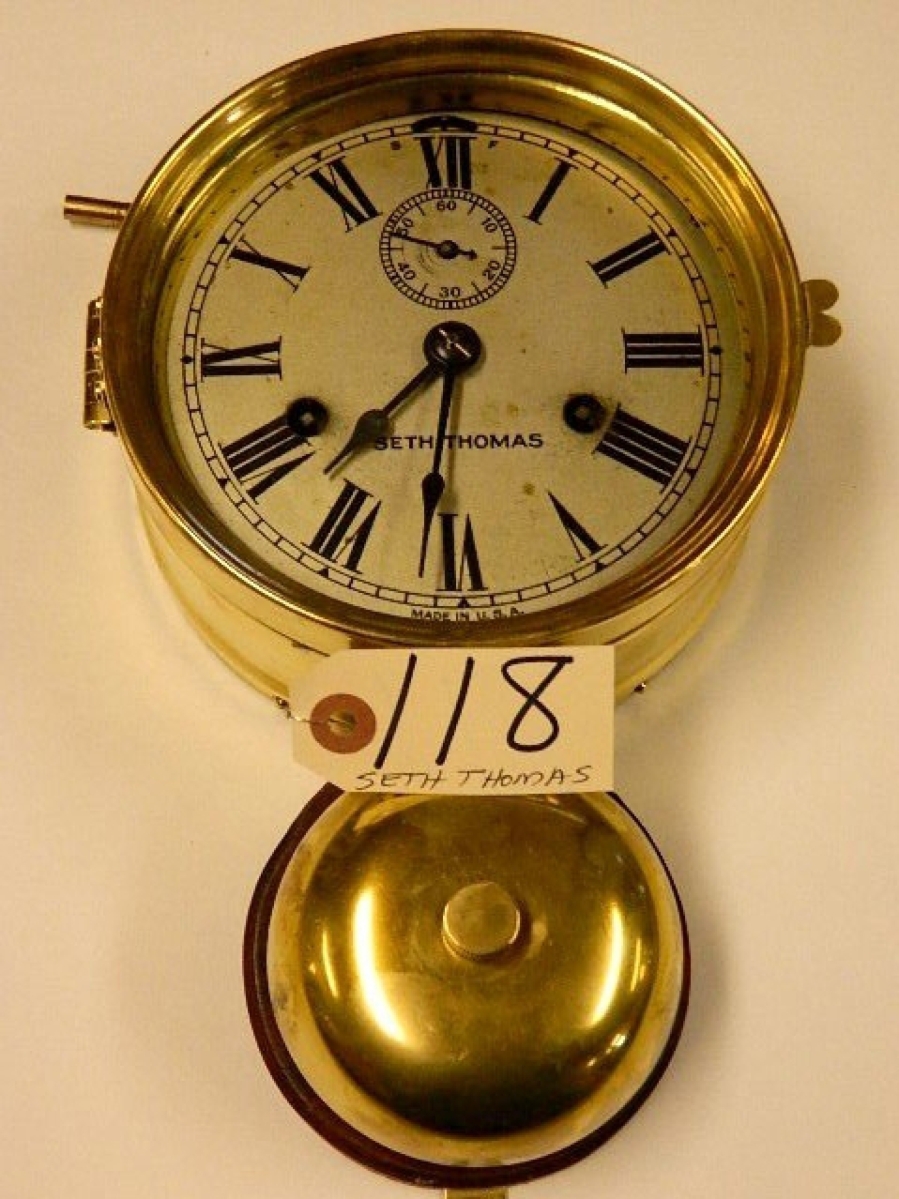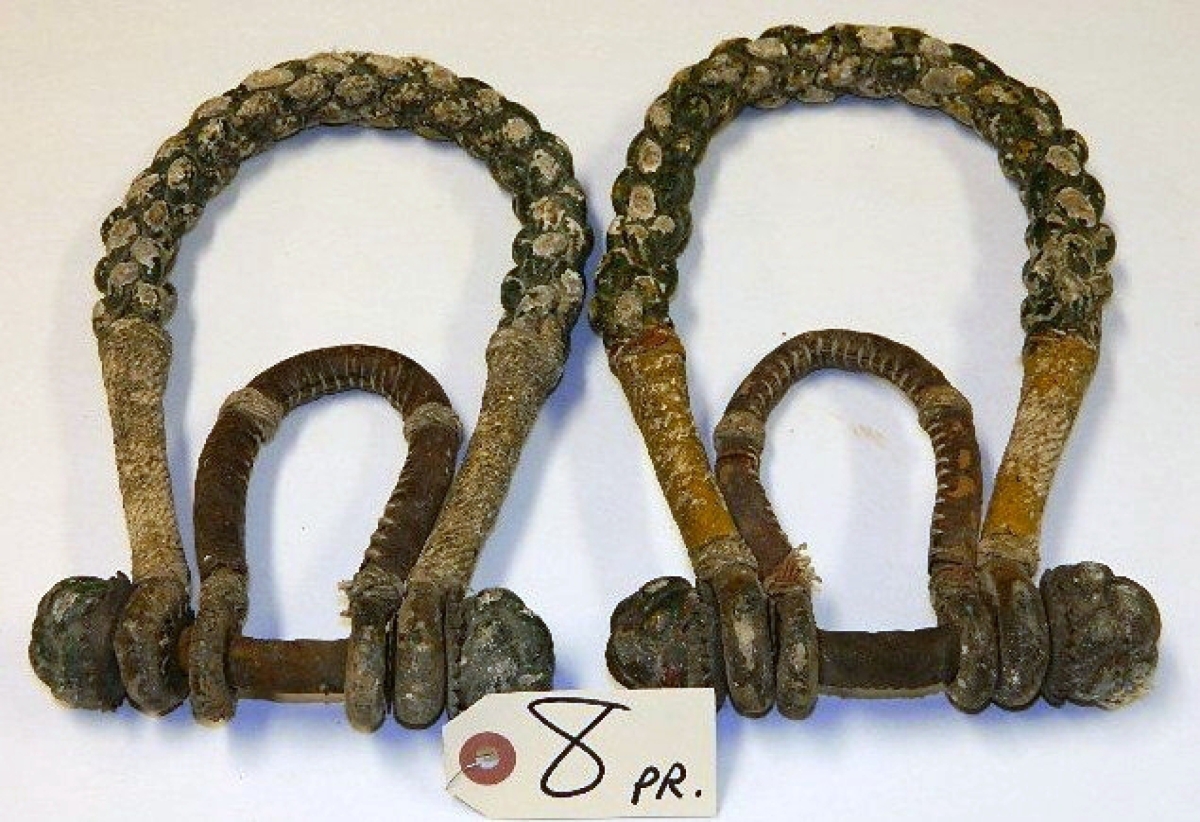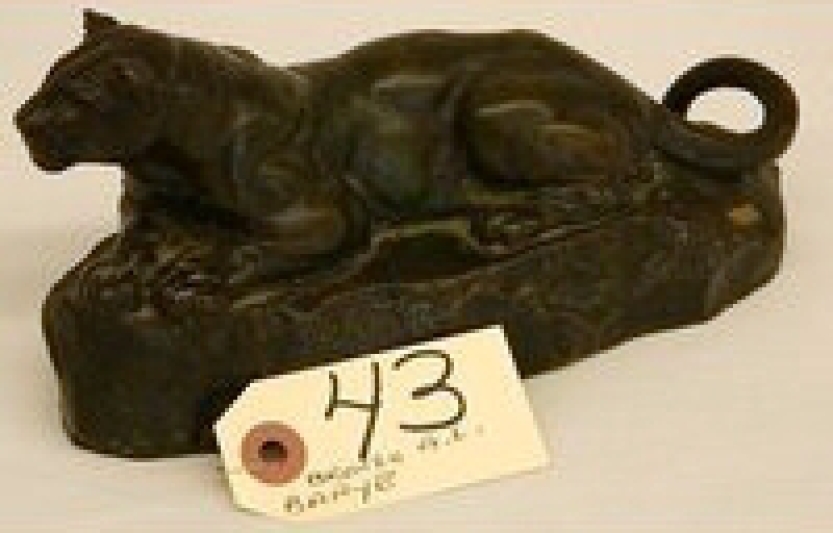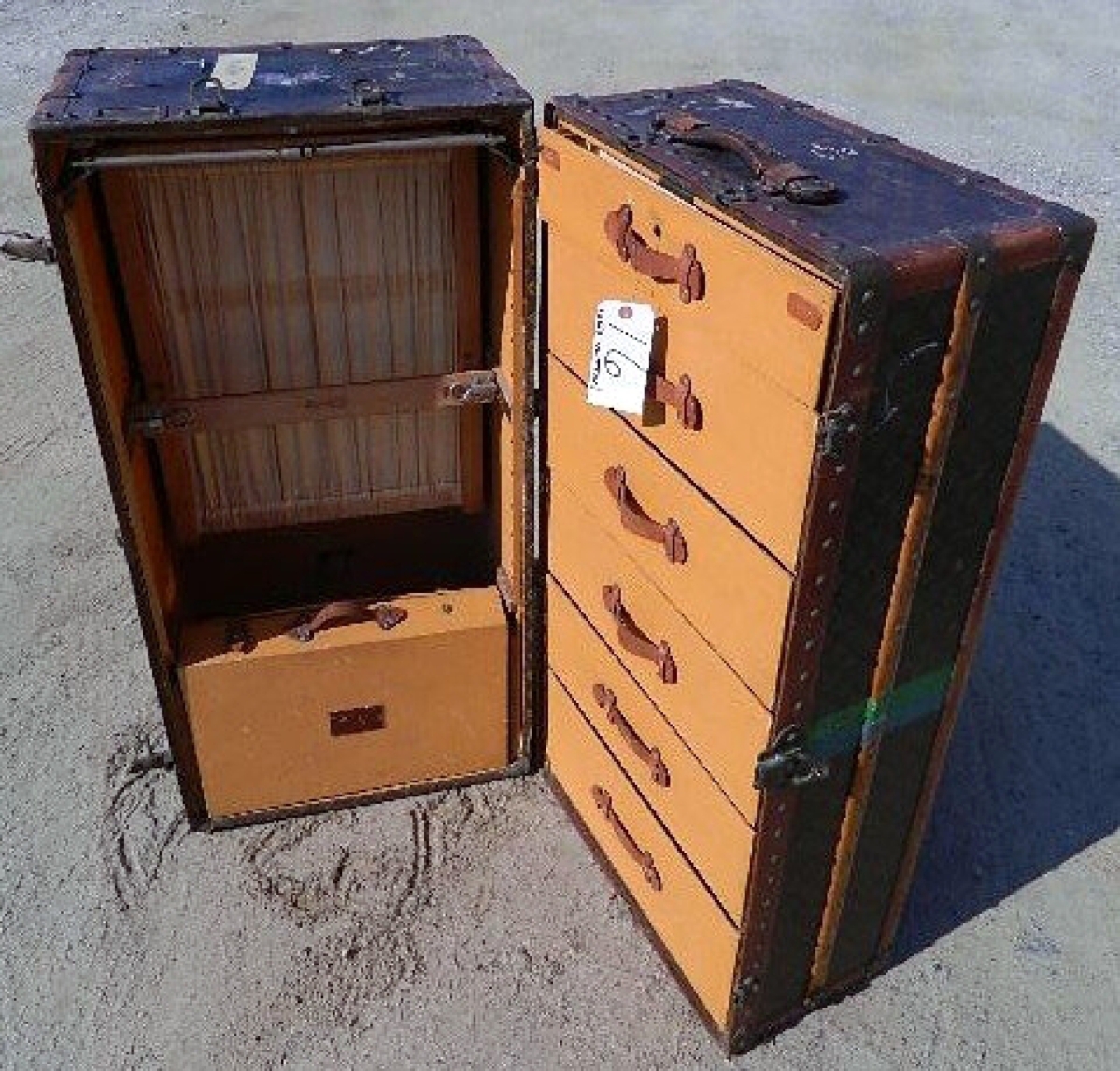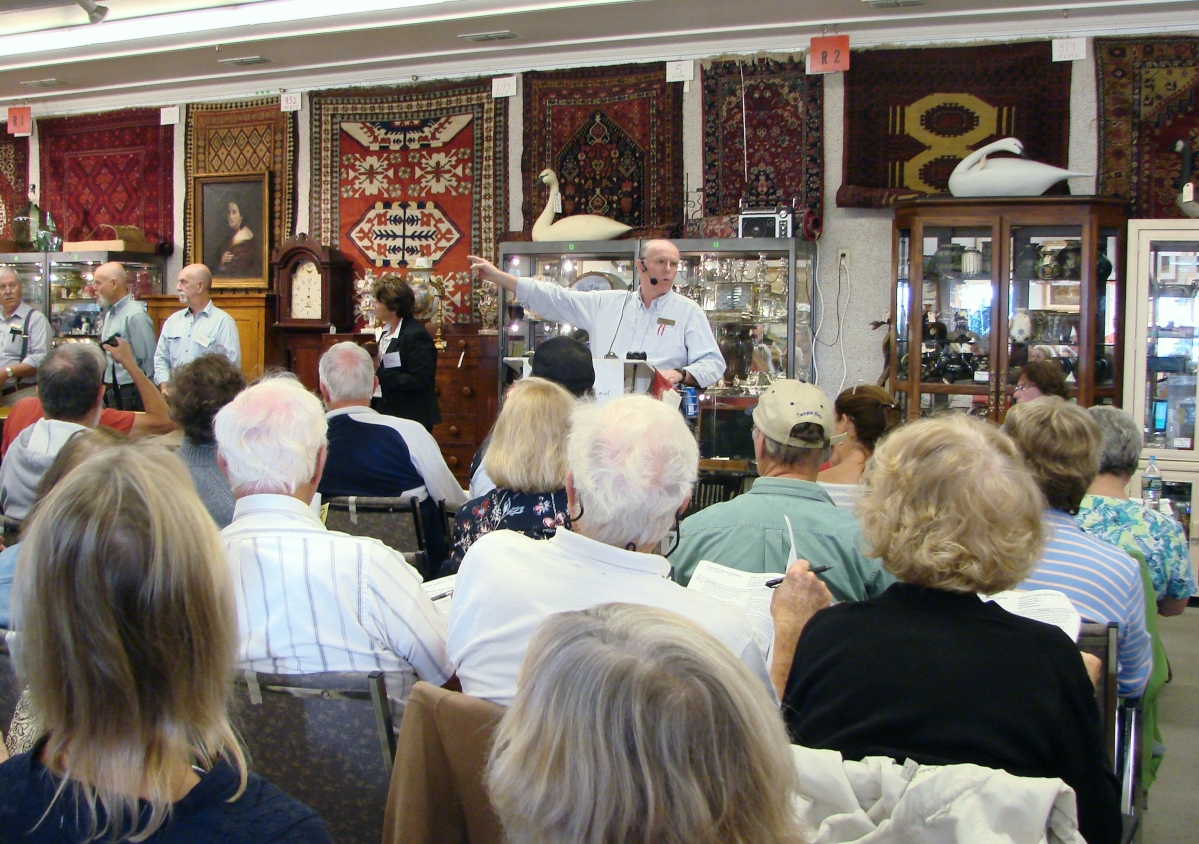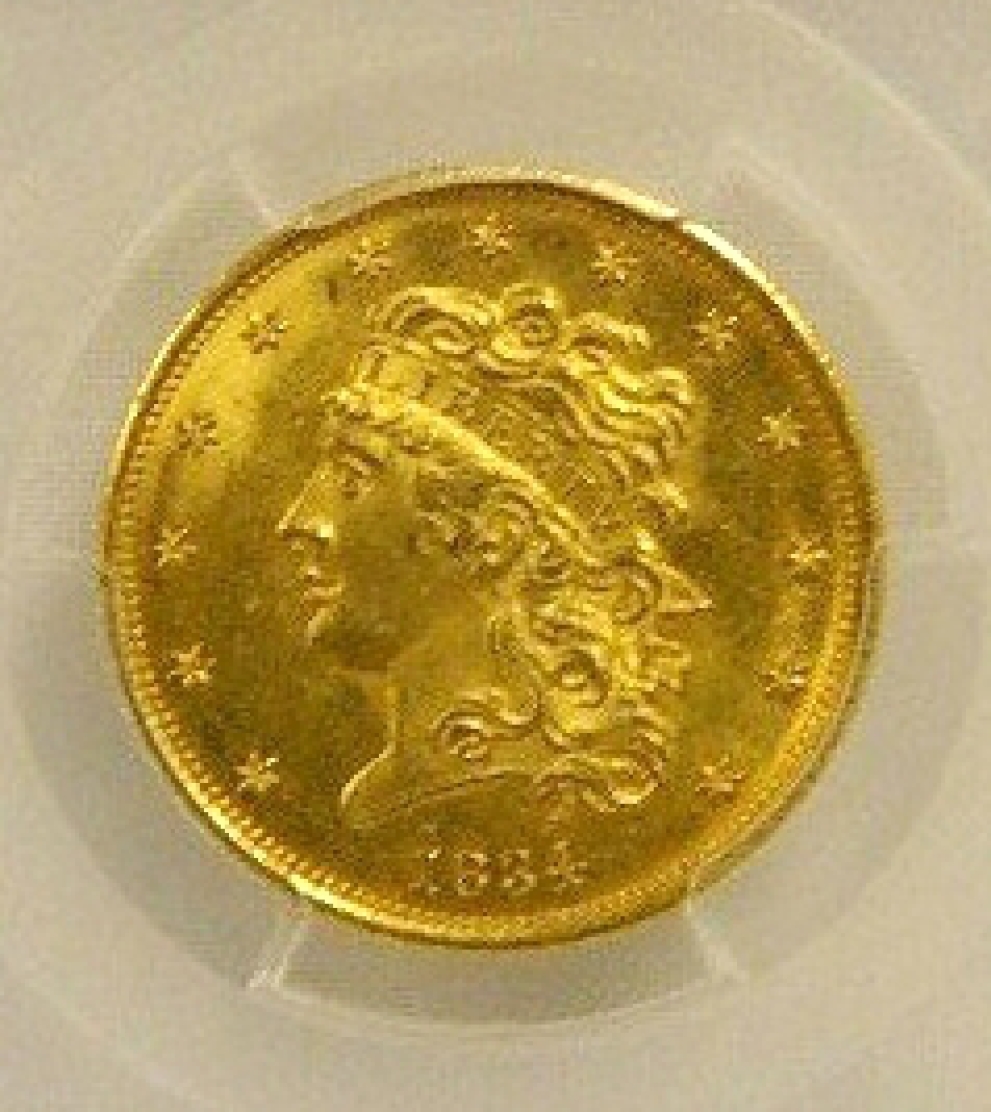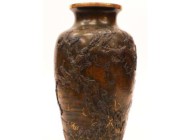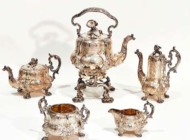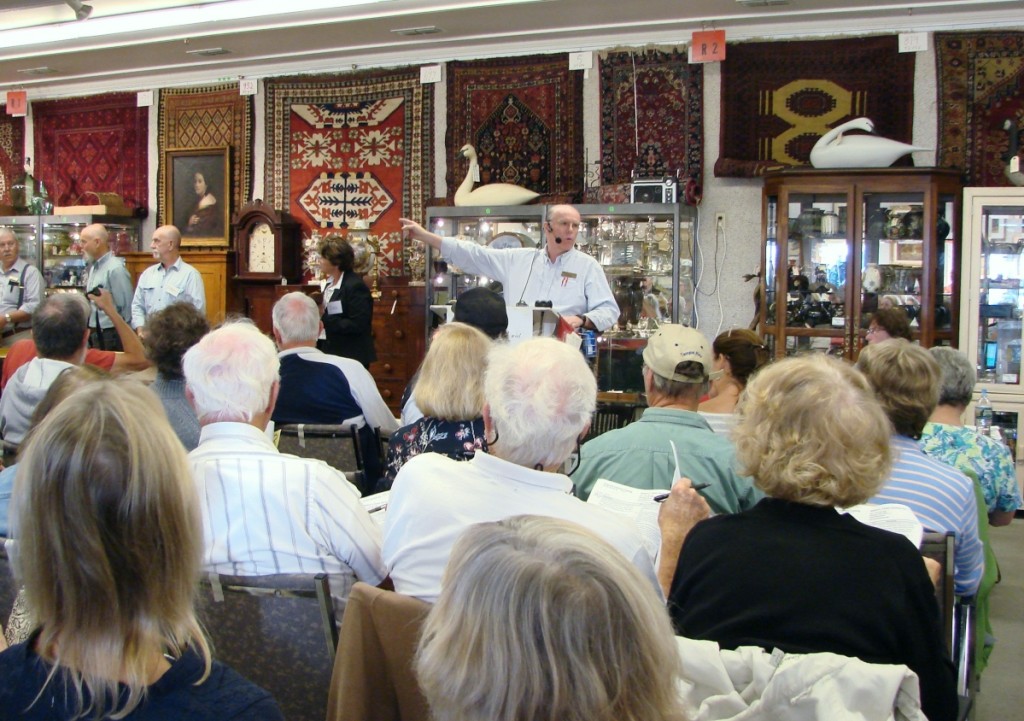
Bob Foster is shown at the podium with some of the day’s offerings behind him. He runs a fast-paced sale, moving close to 100 lots an hour.
Review and Onsite Photos by Rick Russack, Catalog Photos Courtesy Robert L. Foster Auction Co.
NEWCASTLE, MAINE – Bob Foster Jr conducted his annual summer sale Saturday and Sunday of Labor Day weekend, September 2-3. Twelve hundred lots crossed the block in the fast-paced sale. More than 300 people packed the room, with many standing. The sale had enough variety for all: early furniture, numerous oriental rugs, firearms, coins, jewelry, folk art, fine art, Oriental material, art glass, country woodenware, ethnographic material, samplers, nautical items, and more.
A collection of 29 paintings by controversial American painter Louis Michel Eilshemius (1864-1941), collectively bringing $60,950, was the highest grossing material in the sale and the single highest-priced item was a Louis Vuitton wardrobe trunk for $11,500. An 1834 $5 gold piece led the second day, finishing at $9,775. The two-day sale grossed almost $600,000, evenly split between the two days. Less than a half dozen lots were passed the first day, and none were passed on the second. Foster attributed this to the fact that all his material is fresh to the market, and nearly everything is sold without reserves.
Prices for the Eilshemius paintings ranged as high as $5,635 for “Date Palm Trees,” circa 1915, while some of his watercolors sold for as little as $345. Almost all sold to absentee bidders. He was known for his nudes and one, “Nude Below a Window,” realized $2,243. While works by Eilshemius are in the collections of the Museum of Modern Art, the Metropolitan Museum of Art and others, he received little recognition during his lifetime – and loudly complained about it. An exhibition of his works was held at the National Academy of Design in 2001.
In the catalog for that exhibition, an essay by Steven Harvey, “Against the Grain: The Paintings of Louis Michel Eilshemius,” stated: “If he is known at all now, it is mostly as a legendary bohemian figure of early twentieth-century New York. He referred to himself as the Mahatma, the Supreme Spirit of the Spheres. Eilshemius was multifaceted, describing himself as a painter-poet-musician. He wrote and published poetry and prose, composed music and painted. In his later years he promoted quasi-scientific discoveries in pamphlets, including his ‘patented’ self-painted frames. He proclaimed himself an ‘Educator, Ex-actor, Amateur All-around Doctor, Mesmerist-Prophet and Mystic, Reader of Hands and Faces, Linguist of 5 languages,’ a ‘Spirit-Painter Supreme,’ as well as the ‘most wonderful and diverse painter of nude groups in the world,’ whose middle name is ‘variety.’ While all of this adds up to a picture of a vivid and grandiloquent eccentric, it also has served to obscure his painting.”
Reached after the sale, Harvey, a New York art dealer, said that the prices achieved at this sale were consistent with the current market value of works by the artist. There was also a major 1978 exhibition on Eilshemius at the Hirshhorn Museum and Paul Karlstrom, former West Coast director of the Smithsonian’s Archives of American Art, wrote an essay for that catalog, Eilshemius and Modernism. Karlstrom stated, “His work is often uncomfortable to look at and not meant to soothe the eye or mind. In this respect he is a complete original.”
One of the paintings had a collection label indicating that it had belonged to Edith Gregor Halpert. They came from the estate of Robert Fitzgerald, which had a large number of the artist’s works. Foster sold them in three sales over the last year, and commented that this last group seemingly brought stronger prices than the first two sales.
There were numerous other paintings in the sale, most selling for less than $1,000. Works by Maine artist Parker Gamage (1882-1960) brought less than $500, with one example, a scene of rocks and surf at Pemiquid Point, Maine, ending up at $489. A landscape by John Francis Murphy (American, 1853-1921) went out at $834, and an oil on canvas by Edmund Franklin Ward (American, 1892-1991) of a lobster boat and shack achieved $460. An oil on panel, “Nowhere Cold” by well-known dealer and auctioneer Chris Huntington, fared well, fetching $1,006.
Foster runs a fast-paced auction and groups some of the material into lots of several similar objects, seemingly providing a good buying opportunity for dealers. For example, seven pieces of mercury glass sold for $58, 43 pieces of Rose Medallion earned $432, 17 coin silver serving spoons reached $345, ten hand-forged wrought iron accessories achieved $345, a stack of four round pantry boxes with old paint reached $345, and a lot of 38 blown glass fishing floats went for $213. A collection of 12 eel spears, with some signed by the makers, reached $633.
There were a number of other interesting items in the sale. A full-bodied Black Hawk weathervane reached $2,875, a wooden parade staff with a carved and painted coiled snake on the staff fetched $1,725, a rare gutta-percha case, “The Volunteer Fireman,” with a tintype of a woman brought $403. According to Foster, fewer than 50 examples of this case are known. A hand forged wrought iron bear trap reached $432 and a fan pattern quilt with embroidered flowers and frogs reached $460.
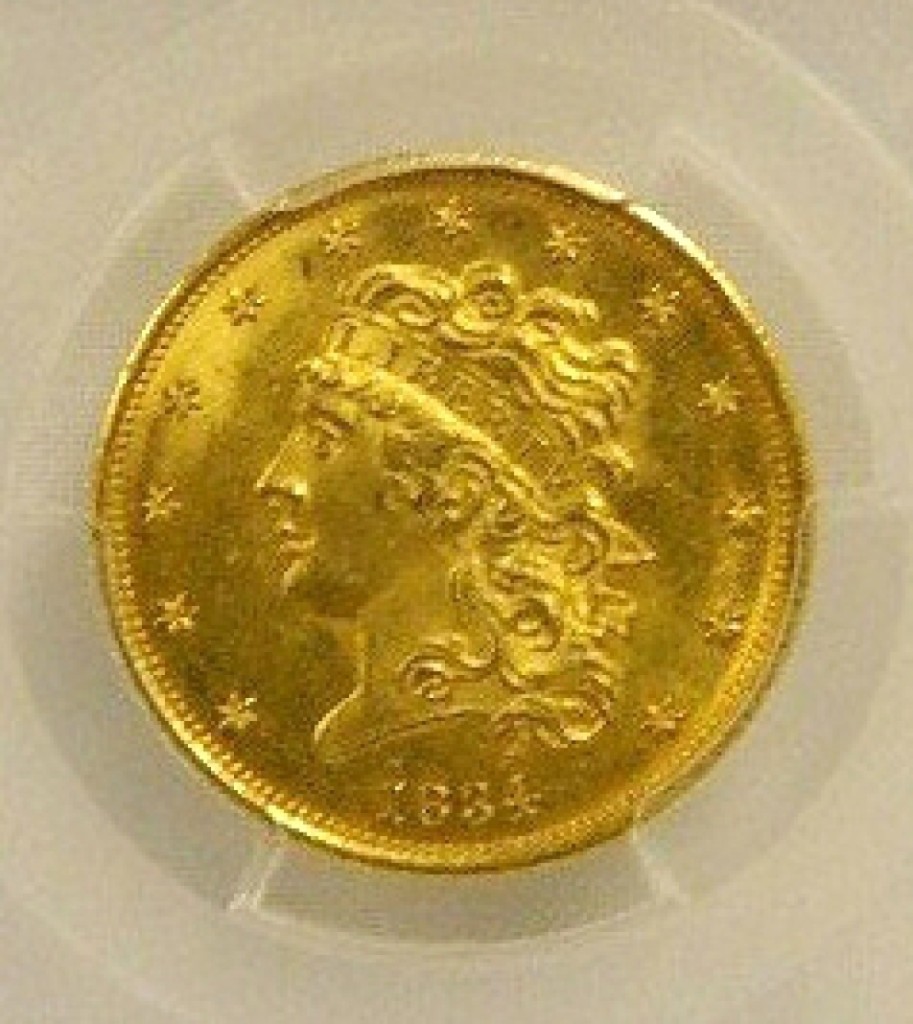
The highest priced item sold on the second day was an 1834 “Classic Head” $5 gold coin, in choice uncirculated condition, which finished at $9,775.
The second day of the sale was led by a strong selection of coins and jewelry. Topping the day was an 1834 MS63 (choice uncirculated) “Classic Head” $5 gold piece that brought $9,775. This coin, and several others, bore PCGS certification. Numerous coin dealers were in the room and good gold coins did well. A lady’s 14K gold ring with three mine-cut diamonds, and a total weight of 2.50 carats, topped the jewelry offerings, reaching $7,015. It was accompanied by an old appraisal, valuing it at $23,350. Another 14K gold ring with two .75-carat Chatham created emeralds, which had been appraised in 2014 for $18,365, realized $7,763. Foster later said that many of the coins and jewelry pieces brought more than he had expected.
Bob Foster grew up in the world of antiques. His father, Robert Sr, was an early exhibitor at the Winter Antiques Show, and also conducted auctions. As a youngster, Foster helped at his father’s auctions and took over the business in 1978 when his father died. “I had been supporting myself digging clams. But I decided on the antiques business when I sold a refinished sea chest for $300. I asked myself, ‘How many bushels of clams would I have to sell to make that much money?’ and the decision was easy,” he said.
“We conduct about 25 sales a year, two of which are Americana sales, like this one. We also buy jewelry, and gold and silver. We have six or seven full-time employees and about twice that number of part-timers. We usually fill the hall since our buyers know they’re not competing with the internet and that also allows me to sell close to 100 lots an hour.”
Throughout the sale, Foster would often ring a dinner bell that was attached to the podium. When asked why, he said, “That’s how I communicate with my staff. I can signal them to move merchandise to or from the front, and whatever else they might have to do. I’m probably the only auctioneer in Maine who uses a bell for communicating.”
After the sale, Foster said that he was pleasantly surprised with the level of interest in the coins, jewelry and silver. “We also had a lot of interest in a group of 34 jade, agate, glass and porcelain snuff bottles, which sold for around $5,400. A lot of the stuff came from an elderly gentleman in Harpswell, Maine. I called it the ‘Harpswell hoard.’ When I was at the house I noticed that some closets had locks on them because the guy had been renting out the house. He had forgotten what was in those closets and didn’t have keys. We unscrewed the locks and found boxes of gold coins, several old firearms, and much more. He was happy to have us take the stuff and very pleased with the results. It was an example of one of the things I really love about this business. We get a window into the lives of these people and the stories often really grab me.”
For additional information, call 207-563-8110.

